#501 My Private Chinatown
MEMOIR: My Private Chinatown
by Grahame Ware
*
The literature of remembrance turns the lost world of objects into emblems of a bygone culture. What is lost can be repossessed through memory and writing, for it is in the vagaries of consciousness in retracing lost dreams that possession can best be established. Writing about memories of these objects and experiences of these objects becomes a way to repossess a lost personal past, a lost culture, and a lost country. – from Wai-Yi Li, The Collector.[1]
*

I was twenty years old when I moved into Vancouver in 1968 and started working at the BC Hydro Electric Meter shop. I was working there because I was a recovering hippie, a proselytizing poet, and one of three defendants in a Supreme Court trial represented by Tom Berger. I was but a teenager of nineteen when these events unfolded. My crime was having sold a nickel bag of pot to two undercover RCMP officers, Cardinal and Brown, in Canada’s first undercover drug bust directed at hippies. The undercover agents had come to our house (the basement of the Peace House on Point Grey Road), became mates with us, and smoked our pot. Then, of course, they wanted to “score” some grass and we accommodated them.
A few weeks later, they busted us. Today it would be called entrapment. Abe Snidanko, the famous (and now late) narc of that era, had rousted us a few times before this, leaving our wall collages in shreds and the house thrashed. He’d always come away empty-handed, but his young, incognito police pals got us this time, undoubtedly with Abe’s help. After I was arrested, I spent a horrible first night in a cell at the Vancouver Police station with moaning junkies and raging drunks before I was on remand and incarcerated in Oakalla prison for about two weeks.
The worst thing about going to Oakalla was the processing. Getting the “haircut” was curiously violent. The sneer on the barber’s face and his relishing of whacking off my locks in front of a procession of inmates, gave the moment a Brechtian quality. When the first chunks of hair hit the concrete floor, there was a faint thud. I felt like my aura had been cut into and my psychic scalp was bleeding. To this palooka, he was just knockin’ off another cut for a punk in four minutes’ kinda thing. “Welcome to Oakalla, kiddo,” he mocked as he whipped off the cape and snapped it to get rid of the hair.
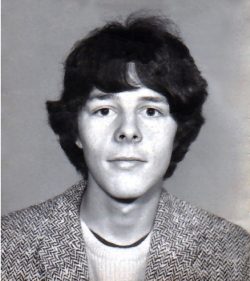
The inmates continued to stroll by the windows outside. They were mostly angry, young, and Indigenous. They were amused at the hippie scalping, something happening more frequently. I was stunned at the droll harshness of the barber. That basic expression of personal freedom, my hair, had been chopped and was quickly swept away from the burly barber’s zone as was I, up to the West Wing. My first cellmate was also on remand and he was up for murder. Just a young guy too. Eight months later, after a three-day trial, fortunately I was acquitted but my buddy spent six months in minimum security New Haven.
Now I had to pay my legal bills and get my life in order. No more the two-tone, silk & poly purple striped bell bottom pants, the Second World War khaki great coat, the custom black leather Beatle boots by Gabor on Hastings, the black derby hat. The consciousness-raising, create-an-artist party/ experiment was over — for now. Ah, but later when Jethro Tull, Led Zeppelin, or Pink Floyd came to town, they were at the ready! For now, my mystical Piscean personality had to undergo a transformation, and alter that urge to seek the Muse at whatever costs to my being in the name and service of art and poetry.
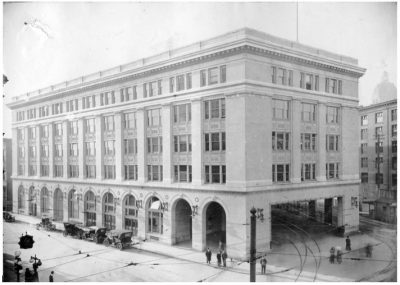
The Electric Meter Shop was my own self-directed work and recovery program, a way to get into some regular, productive habits and make some dough. Once again I needed to wrest back control of my freedom and life. No more the vulnerability of hitchhiking everywhere and suffering through advances from large, serious gay military men in Stanley Park or drunk businessmen with fancy cars.
Now I could afford my own car or motorcycle, buy records, enjoy life a little and, just generally, de-paranoiafy and enjoy my own space. The hurt from the legal whip still stung, the welt of shame and bewilderment was now lodged in my gaze. But the frisky hippie pony was mostly broke. I strapped on the working class harness, showed up every morning, stuck my nose in the oat bag at noon and tried to keep my stall clean. Located under the old Georgia Viaduct where Carrall Street’s south side ends, the Electric Meter Shop building was an old beaut having been built in 1912 to serve as the hub of the BC Electric’s Interurban transportation system. Ten thousand people a day went through the building’s station every day before the Interurban ceased operation in 1958, bowing prematurely to the primacy of the car and the suburbs. The building was retrofitted by BC Hydro to house the Electric Meter Shop for repairs and quality control. Originally, the site was a Chinese laundry (and later Yick Lung Jin tailor shop) owned by a Mr. Chang Toy. He sold it in 1903 to the BC Electric Railway Co. After all of these events, the meter shop at 425 Carrall has now morphed into a trendy retail shop complex owned by Anthem Properties.

My specific job was to wash and clean the glass electric meter covers after their seals had been broken for servicing. I would then put 64 meters on a rack with wheels and take them upstairs for calibration and testing on a small service elevator. Back downstairs at street level, in my cleansing domain, I would don a thick rubber apron and gloves topped by a plexiglass face shield and clean the glass covers in huge tubs using a powerful alkaline powder. This was done under stately, large arched glass windows complete with large and functioning transom vents. These were opened and closed with a large oak pole (complete with a snapping brass hook) that stood hanging in the corner on its own cast-brass hook. I’d try to do 128 meter covers per day. Usually I could get away with two scoops to make two baths if the meter covers weren’t too dirty. The busiest day I ever had was when a whack of meters came in from Chinatown. They were covered with grease that was caked on in layers. I had my first and, as it turned out, my last four-scoop, four-bath day.
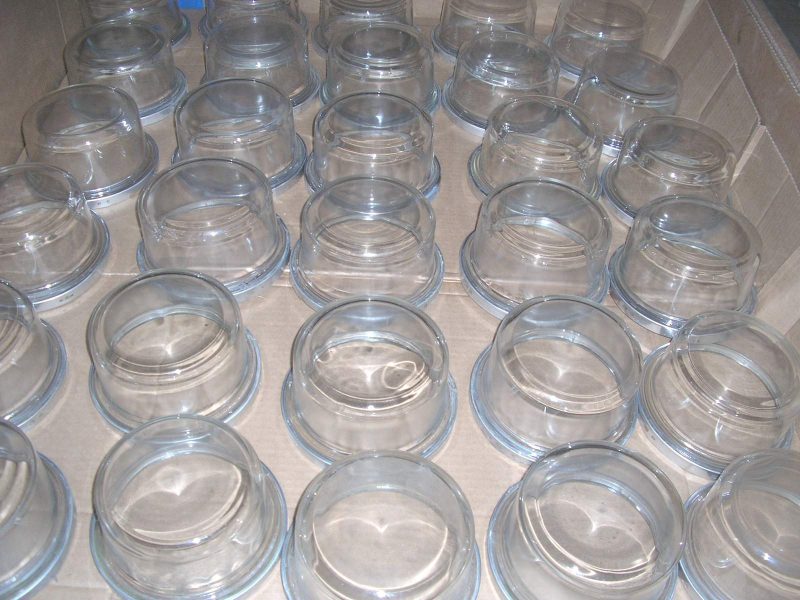
*

What helped me immeasurably in recovering from this whole ordeal was the freedom I found living and working in this old part of Vancouver. This freedom was bound up in my relative anonymity and being among many people just like me. After the trial, I stood out in my old stomping grounds. The wooded acreages and sub-suburbs of sixties Surrey just couldn’t give me enough cover and camaraderie. I felt at home here in the east end and Chinatown, among the streets and buildings. This was why my private Chinatown was private; where being down but not necessarily out was a universal condition unmarred by working class shame, middle class egos, and the collective conceits of the culture. This part of Vancouver had much less judgment and conformity and many more traditions, crafts, and personality. Somehow it felt timeless or, at the very least, much more permanent than Surrey. The architecture and the buildings of Chinatown were far more charming than the 2” x 4” instant suburbs of Surrey. They were brick-by-brick handcrafted cultural vessels that housed a spirit of design and a collective energy. They whispered to me in the tongue of the wind, “You’re at home here. We’ve fought against societies like this before.”
The chop suey cafes with their neon totems beckoned on those cold, rainy nights. These were the beacons that attracted the large working and student classes of the time into Chinatown. With neon coursing in their glass arteries, their signs declaimed the portal that was both a refuge and a cultural consort. The atmosphere, like the food, was unbelievably good.
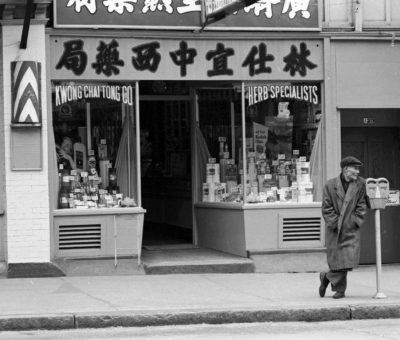
From my workstation at the meter shop, I looked across the street to a dull Acklands warehouse wall. Next to that on Carrall was a Chinese benevolent society building, the Lim Sai Hor (Kow Mock) Benevolent Association. It had been an important gathering place for Chinese since the First World War. I walked by this building at least twice a day. It backed onto Shanghai Alley. One day I detected a distinctive odour coming from the building. I could hear Chinese men’s voices at the top of the building and stopped to listen to the activity. They were having fun playing Mahjong or GO.
Just then, a friend from SFU was standing next to me and asked what I was doing here. I filled him in and then asked him what he was doing here. He said he’d come to pick up his granddad for his shift at his tea and herb store on Pender, the Kwong Chai Tong.
“What’s that smell? I said.
“Opium of course!” he chuckled, making a mocking face of disbelief.
“Wow!” I said.
“Would you like some?” he asked.
“Sure.”
“You’ll only get what’s left over from the first smoke though,” he cautioned.
“OK, fine.”
I must admit, the opium didn’t do much for me. Not as much as the Lapsang souchong tea from his grandfather’s store on East Pender.
His granddad was a character. The store was amazing. Tins and jars and a wall of drawers of every imaginable herb and tea. One day I popped in and my friend was there with his granddad minding the store. The mood was a little lighter when his granddad knew that we were friends. I’d been in about six or seven times before and he knew that I was working my way through the teas. We had a little talk about my preferences, and I blurted out that Lapsang souchong was the best.
The granddad chuckled and turned to his grandson. “Tommy, your friend here is pretty smart;” and then, pausing for effect, he turned back to me: “For a white boy!”
He broke out in a big smile and I, an uncontrollable horselaugh.
*


As a result of working there and living on Victoria Drive, I had occasion to eat a lot of terrific Chinese food in Chinatown. It was 1969 and a friend suggested we go to the Ho Inn one Friday evening. I liked the scale of the place and the energy. The place had soul. My friend Trevor said that he’d heard that the sturgeon and greens chop suey was good, so we ordered that. Out came the meal on a huge oval plate shimmering with heat and zest. The sturgeon and greens were just incredible — the sturgeon was firm and succulent, just as good as halibut in that way but lighter and less heavy. The Gai Lan, Bok Choy, and onions were fresh and along with the indispensable bamboo shoots, slices of fresh ginger and sauce, it was a scrumptious meal. The sturgeon did a great job of taking on the flavours of the greens and sauces without losing its wonderful meroir. It cost $1.50.
I’d regularly order that dish with the occasional selection of something else like the rock cod with greens, the Ho Inn special chop suey or, once in a while, one of their “real Cantonese” dishes, barbecue duck. This last dish hooked me onto a real love for Chinese BBQ meats. The real surprise in all of my menu testings was the abalone chop suey. Unbelievably tasty. But I always came back to the sturgeon and greens. It pays to tip a little. I got to know the headwaiter, Mr. Kwan, who remembered me and knew what I liked when I came in.
I had grown up and lived in Vancouver until I was eight and being back on Victoria Drive and working on the fringe of Chinatown, I was happy that I was back here.
One of my notable childhood experiences as a kid came when a Chinese fishmonger came wheeling down our street at Third and Cassiar with a wheelbarrow full of fish on ice.
Up the hill he came, stopping at every concrete door-path on the street, placing his wheelbarrow down and knocking on doors to see if anyone was interested in his fish. As a curious imp of five, I came over to the wheelbarrow to look at the fish and then had the bright idea of helping him by taking the wheelbarrow to the next house. While he was preoccupied with a potential customer, I lifted up the wheelbarrow, took two steps then lost control. It was just too big and heavy. Over it tipped with all of the fish and ice smashing and splaying on the sidewalk and grass. Suddenly wracked with guilt, I stood there as frozen as the spilled ice for a few seconds … the dead fish eyes seemed to scowl and off I ran. The fishmonger saw this and became upset.
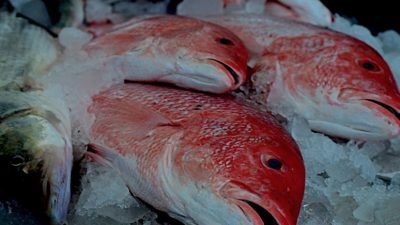
He picked up one of the fish and brandished it over his head and came out to the accident scene, his queue whipping from side to side under his silk hat. I was afraid for a second but scampered away and made it to my house safely. After my door-slamming out-of-breath entrance, I told my mum what had happened, and she told me that I’d have to go back out and apologize to him. I knew that I’d done something wrong and now I was full of shame. I started to cry in dread but I went back out onto Cassiar with the tugging assistance of my mum’s arm.
My head was down, and sobbing and blubbering, I managed to say I was sorry. I helped him put the fish back into the wheelbarrow, bits of mown grass still sticking to the fish. He’d calmed down by now and was more sad than angry. He felt sorry for me. A kind man, he looked at me eye to eye as he crouched down to scoop up his offerings and take some of the fish out of my hands. Between apologies, my mum bought some fish along with another sympathetic neighbour. Then off he went up the street as I waived goodbye to him. It had all ended well somehow but I don’t remember seeing him again on our street.

That Halloween I dressed up as a Chinese man with a little blue silk hat with built-in queue, blue silk shirt, and pants with red dragons on them (Chinese clothing was so cheap in the 1950s). My mum got out her make-up kit and pencilled in a slim moustache and extended my eyes very carefully. Much to my delight, I truly believed I had fooled every neighbour on my candy collecting rounds. I was so proud of being Chinese for a night that I refused to undress when it came to bedtime. I really felt like someone and I didn’t want that feeling to end. My mum, somewhat bemused, tucked me in. My moustache was smudged in the morning. The sleep and the Maybelline in my eyes ran and stung as I washed it out as few times. I couldn’t get it all off but it didn’t matter as I wandered off to kindergarten. It was all worth it.
*
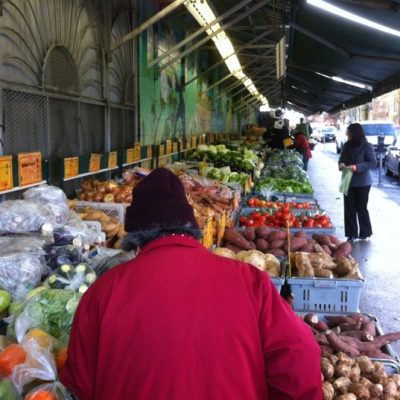
While working at Coop Radio, or attending SFU in the seventies, I would hang out in Chinatown. Besides places to eat, there were tea and herb shops, places to get Red Korean Ginseng extract, and green grocers with astonishing produce. Eating at the Ho Inn had inspired me to buy vegetables from many green grocers including the Sunrise Market, starting my life-long love affair with that place.
I began to patronize the market gardens in the Lower Mainland run by Chinese. These gems could be found on Marine Drive, often between auto wrecking places, lending a whole new meaning to the term “truck garden.” There were also some Chinese gardens out in Richmond and Surrey, especially Wings on No. 10 Highway and Johnston Rd. It also motivated me to grow my own Oriental vegetables: Gai Lan, Daikon, Bok Choy, Sui Choy, along with the usual carrots, lettuce, Mizuna, and tomatoes. And even if these places weren’t Chinatown per se, they were connected to it – they were the outer spokes in my Chinatown wheel connecting to the hub in my daily, weekly, and monthly round of activities.
The smells and energy of the vegetables and the atmosphere of these gardens were part of my sensibilities as much as Kits or New West. But like everything else, you develop your own relationships and likes or dislikes. Chinatown was no different. Kits would never be home like Chinatown even though it was cute in its nascent, pseudo-Bohemian way. And New West was getting prematurely dowdy. Nowhere else had the soul of Chinatown. It was my home now.
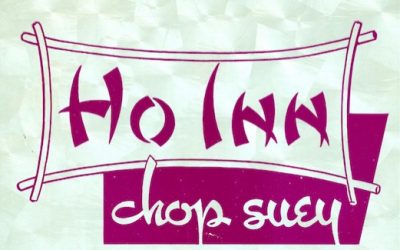
I remember the last time I ate at the Ho Inn, in 1982. I was crestfallen — there was no sturgeon and greens on the menu. Mr. Kwan was still there and still the headwaiter. I reminded him that I’d been coming to the Ho Inn since 1969 and had “my” meal probably forty times. “What happened,” I asked, smiling in disbelief. “It was the best thing on the menu, why don’t you have it any more?” Looking off and recollecting his memory, he said, “Ohhhhh … cook who catch sturgeon on Fraser, he die.”
It turns out that the dead cook, like others who worked there, picked up a little extra money by catching fish for their kitchen. No wonder the sturgeon was so good; it was fresh from the river. Mr. Kwan wasted no time touting the rock cod with greens as the best sub. So, for my last meal there, I had that. The rock cod (snapper) had been caught locally as well. It was delicious.
In the end, though, there was no place as good as the Ho Inn. They stopped serving after a fire in 1987. Apparently, a van caught fire in the alley and spread to the building at 79 1/2 East Pender.
Their style of cooking was what people now refer to as “village style Cantonese” food (essentially home cooking with local ingredients that are fresh). But as for chop suey itself, according to the food scholar E.N. Anderson, it traces to tsap seui (杂碎, roughly translated as “miscellaneous leftovers”), common in Toisan, a county in Guangdong province, where so many of the earliest immigrants to Victoria and Vancouver can be traced.[2] I loved most of the iterations of chop suey and wanted to cook in the “village style.” Mr. Kwan kindly informed me that Ming Wo Hardware was where I should go. It was just a few doors down on Pender. Thus, I got my wok and utensils and my first serious knife, a Henckels, which I still have and have used for almost fifty years.

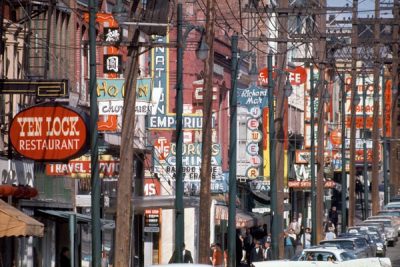
As for perfecting my style, my main limitation was that I had an electric range and so the “fire and air” or bao (爆 “explosion”) method of the pros in Chinatown was hard to reproduce for an authentic stir-fry. Still, the oils and sauces came on board, and I discovered how to use them. The results were as good as expected. What wasn’t hard to perfect, though, was the slow poaching of fresh chicken and then using it in stir-fry along with some of the broth. This was the key to chicken chop suey — along with quickly steaming fresh vegetables — and then finishing them off by stir-frying everything in the wok. The neutrality of the protein was offset by the hot sauces, ginger, etc.
Other Chinese food places that I frequented included the Ho Ho Chop Suey (not as good in my opinion and only when the Ho Inn was packed and I was starved), the B.C. Royal Café, and the Yen Lock.
The Yen Lock had a decidedly artistic quality to its oriental character. The menu was among the most impressive of any on that East Pender strip and they always had lovely plants and pottery in the south-facing entrance window. It is no coincidence that their menu and logo were designed by two very important figures in the embryonic art scene in post-Second World War Vancouver: painter-sculptor Chuck Yip and potter-sculptor, Tommy Kakinuma.
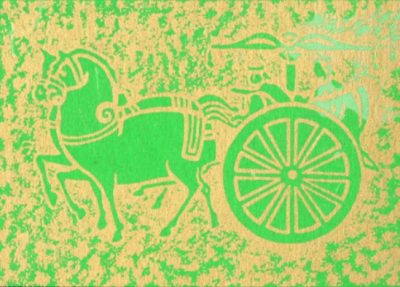
The Yen Lock made some very cool Chinese food, like whole BBQ rock cod with greens. Just once I tried their Gold Coin Beef and I’m glad I sprung for this last pricey offering. Gold Coin Beef was thick marinated slices of sirloin beef stir-fried in a sauce devised by the chef, like a variation on the French medaillons d’boeuf. Upon reflection, this was my first fusion food.
Another notable Chinese restaurant of that era was the fancy Marco Polo Theatre Restaurant. It was often packed because Chinese like to celebrate in large groups for festive occasions — and it had the space and scope that others didn’t. The first Chinese nightclub in Canada, it opened in 1964.
Later on, in the late seventies, Chinese food went uptown to Granville Street with the very impressive Kingsland, which one-upped the Marco Polo for space and style. The Kingsland entrance had some very impressive dragon sculptures of massive and beautifully carved karst. Also, for added ambience, there was a huge, salt water fish tank bubbling away in the corner. Kingsland was more expensive because it had to be; the scale of this set up was beyond anything I had seen in Vancouver. However, the food was still very good value and classy in that western sense. This was when there was a huge film theatre crowd on Granville taking in the flicks at the Orpheum, the Vogue, etc. I suppose Kingsland was a bet on getting more white people to eat in a classier Chinese restaurant while on Granville’s film row, and not having to waste time going on down to Chinatown. I’m not sure where the key Kingsland people went after they closed their doors, but certainly they had a vision that was most definitely ahead of its time.
*
My job at the Electric Meter shop ended. Living and working in and around Chinatown had been a good time for me. I’d weathered the storm and was now charting my own course. Things were affordable there and I loved the scene with the exception of the smackheads and the drunks. Somehow, the Chinese managed to work and live in and around them. I’d managed to get it together and I could now do a little planning for the rest of my life. I bought a little Yamaha classic nylon string guitar and started to strum and pick.
Soon I was off to Jordan River, west of Victoria, working on a hydro dam and living in a trailer with other workers. I composed a song or two in my spare time. I muscled up and kept saving and on my return found a basement suite in the seaside village of Crescent Beach. This put me back in my old orb — Newton, or as the big neon sign on King George Highway near Newton Road (72nd) declared, CHICKEN CITY, with a rooster crowing his glory in red, green, and yellow neon with quite the cockscomb and tail feathers.
Across from that sign was the New China Doll Cafe run by the ever-gregarious Wally. They had but a plain sign. It was the only spot in the Newton area with food that approximated what I relished and had come to expect at the Ho Inn or Yen Lock. But Wally’s Halibut & Chips was superb. Take that, Chinatown! Wally found it amusing that I would be so interested in Chinese food, but eventually his scepticism gave way and we became friends who talked seriously from time to time about food. He spoke Mandarin but had come to Vancouver when he was five so his English was good.
“What’s today’s special, Wally?” was always the first question I asked him. He’d light up with his big, toothy smile. “Prawns & Greens, sonny boy!”

Sure enough they were sensational, having just been bought from St. Mungo’s Wharf down on the Fraser River. It was only later I found out these were striped prawns that now fetch $40 a pound or more.
Once I told Wally that I always talked to the server or owner of a restaurant and asked them what was the special or the best thing on the menu. In my experience, this was the best way to get the best food. Wally laughed. He confided in me that what I was doing was showing respect to them and to the cook, and that they’d give it their best shot because I listened to them. I’ve never varied from that posture whether I was in a Chinese food place or not.
Besides the New China Doll in Newton, Chinatown had come to the suburbs — Shums on Scott Rd., the Rickshaw in Whalley, etc. And beyond the suburbs in little towns all over B.C. you’d find gems such as the Great Wall in Armstrong, which used to be run by Joe and his son. Indeed, was there any place in B.C. that didn’t have a Chinese restaurant with some great chop suey on the menu?
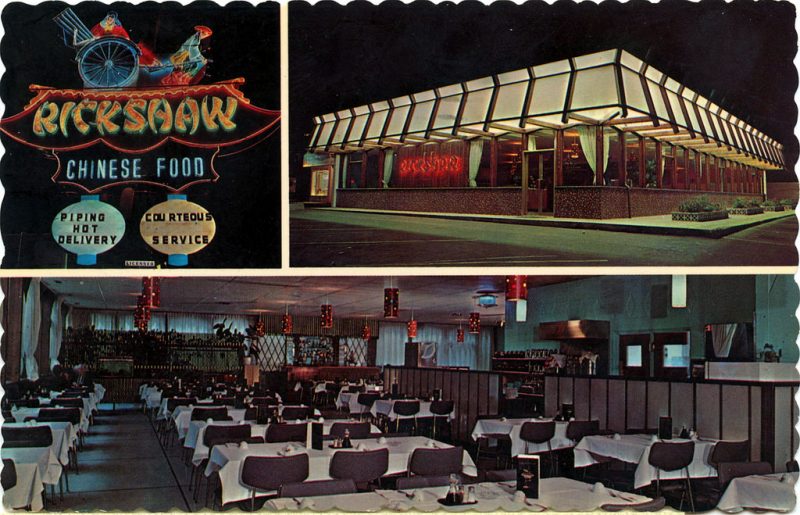
*
Today, Chinatown’s gritty and hard-working soul has been gutted by the effects of too much money chasing too few beachheads and from too many anonymous condos. One wag ruefully said, “You can’t afford to be poor anymore!” The nineties outflow of capital from Hong Kong sealed the deal and the hastened the trend away from good old-fashioned value for money in all of its manifestations. Chinatown was now too small, dirty, and unpretentious. Ah, but the real estate — that was another matter! It was time to build a kind of Kowloon in Richmond. The charge was on and the local Chinese-Canadian working class seemingly vaporized apart from the old people.
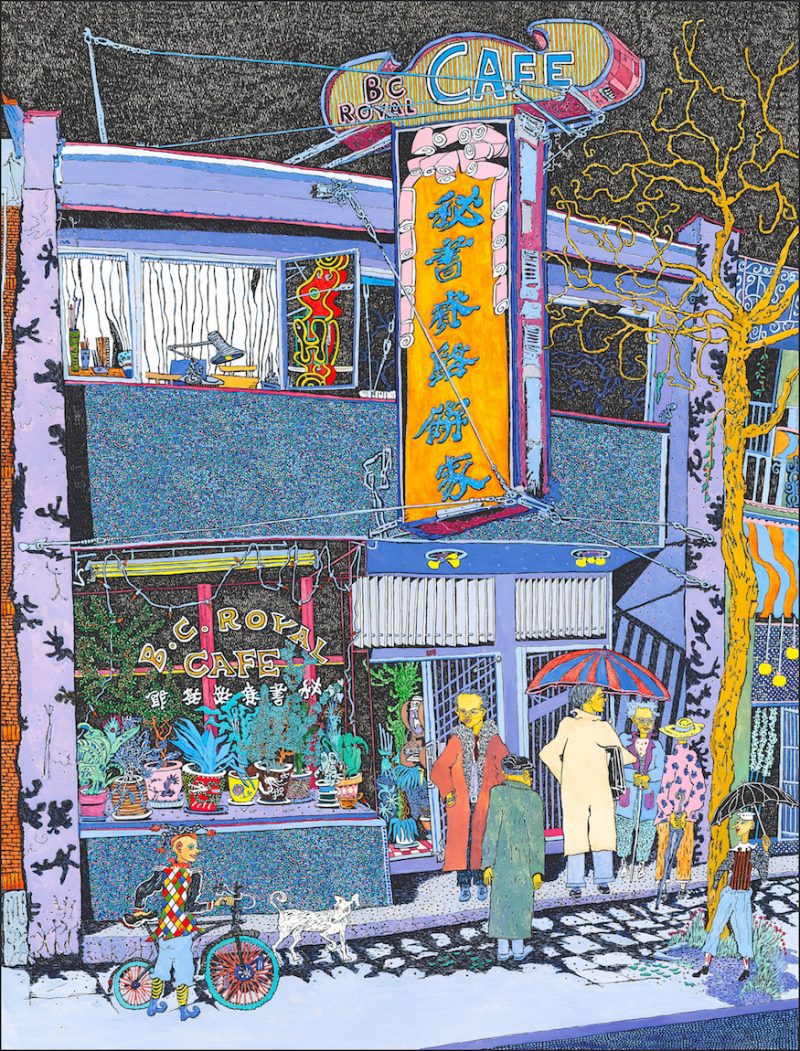
Chinatown has now mostly vanished, leaving only the phantoms of memory. I left Vancouver for Toronto in early 1983 and returned to the southern interior of B.C. in late 1989, so I lost track of places like the Ho Inn, Yen Lock, and B.C. Royal. I made only rare visits to Vancouver and, therefore, the contrast was striking. I was blessed to have discovered the Ho Inn, Ming Wo, and everything and everyone else when I did, and to witness at first hand the hard work, humility, and energy of the people of Chinatown.
Not everybody had the same positive experience. Someone I knew who played in the Vancouver Symphony (3rd cello?), but who had to drive a cab to pay the bills, used to hang out at the Green Door. One night while he was cabbing he popped in and, after ordering his meal, out came the first dish — a bowl of steamed rice with a large pubic hair strategically placed on top. When he looked up, all eyes were on him. He nodded and left, never to return.
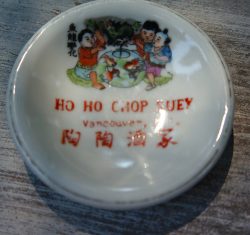
I never had that kind of thing happen to me. I guess they liked me, or maybe I was lucky. Chinatown was a great place to develop a sense of what I could do with food. It inspired me in all my subsequent cooking enthusiasms. This, in turn, led me to growing fresh oriental vegetables for my kitchen. At first, my attempts to mimic the wonderful local Chinese truck gardens weren’t good, but once I got my soil’s tilth where it needed to be, and made some cold-frames, I was off and running. The lesson to me was all quite natural — it starts with food. Food for the soul and food for the body at the end of a hard day’s work — food that made me glad to be alive no matter how hard the work or how tough the times. This went a long way in helping me persevere.
Some ghosts are benign — especially those from my private Chinatown. They showed me that great things come from simple things when the spirit of one’s soul is fully engaged. That, when you are patient and focused, time will reward you. And just like that little boy who was so proud to be Chinese even if only for a night, my private Chinatown still lives and dreams. I am ever- patient and I still believe in time rewarding me, even though I am seventy.
A Sinophile, deeply drawn to this Oriental outpost on the edge of Canada, was created in the cultural cauldron of the fifties and sixties. I was proud of my Chinatown and the two bits that I threw in the pot to keep it jingling along. I got back far more than I put in. It was I who was dignified by all of it and by everyone in it.
Vancouver’s Chinatown helped save a young man and made him realize that, like the Chinese who came here, you can leave your country but still keep your cultural soul; that your country — or another — can lock you up and try you, but it is only you who can acquit or sentence yourself; it is only you who can give up or, at the very least, render a stay of proceedings.
Time can and will change many things, but once your soul has had certain experiences, a new transcultural soul emerges. When this whole thing happened I was young and alienated, adrift at sea. My dis-identification as a postwar west coast Canadian white boy began to unfold as I found my way to shore. I’d bodysurfed my way to this new home and experienced a liberation, an Oriental metamorphosis. Once I had caught my breath and was safely on this new beach with my legs under me, I was never the same.
The recapture of deep memory creates its own present and future. Sentimentality, besides showing respect for the past, can also carve out mindfulness. That is what the pioneer Chinese did when they came to Canada and, specifically, to Vancouver. They kept their cultural heart beating with their foods, habits, language, and sensibilities. They built stores and buildings, just like they had back home. They wrestled with the reality of west coast Canada and fashioned a liminal bridge, a betwixt-and-between structure, over the Fraser River and over the Pacific Ocean. They paraded proudly over this span while I approached from the other side of what they had made. We’ve waved to each other many times on this link and enjoyed the view together while enthralled at the play of light on the flow and ripples of the water.
I may not like what has happened to Chinatown, but that doesn’t matter. I have my memories. The decades and decades of Chinatown’s vitality came to an end. A Marxist analysis would say that the various buildings and their activities (use value) became worth much less than their real estate (exchange value). It was time to leave behind the chop suey, woks, and paper lanterns and beat it on out to Richmond. Of course, this is too glib an analysis but it speaks to the fundamental shift.

Confucius was supposed to have said, “It is better to light but one candle than curse the dark a 1000 times.” This hints at the practicality of life and its necessities; it cautions us not to dissipate our energy with anger. Take your matches to Richmond! If you crave the best food and you want to feel like you are surrounded by oriental sensibilities with a younger and more vibrant energy, by all means Richmond is the place to be.
I believe that we are all but natural abstractions that come and go — the imaginary that becomes real, and vice versa. The realization of this phenomenon inevitably leads to a way of being, a path, where there are but two things left: philosophy and gardens. Lu Shusheng 陸樹聲 (1509–1605) sums it up best for me in his An Account of the Garden of Ease.
This was his garden space that he loved at the end of his life where, he observed, “things have ways to find their proper place” (wu ge you yi zishi 物各有以自適): “And since this is the place whereby I and all things find ease together (gongshi 共適), it is not up to me to own it exclusively. Should I then not be transcendently at ease myself (zishi 自適) in this place?”[3]
But just as with older working class Chinese Canadians who, like myself, bemoan the end of Chinatown, there is more to it than that: what has slowly eroded and faded away from us has also given us something that we could never have had otherwise — the kindness of hindsight, a gift of the distillation of time — namely, a deeper appreciation of the past in the present. Just doing what you wanted for the reasons you had is, then or now, a blessing. What happens and where you end up is immaterial. What is important is enjoying the moment and being in that moment — because we are natural abstractions that come and go. “Should I then not be transcendently at ease myself (zishi 自適) in this place?”
My Chinatown — despite its public recording here — will always be private, not unlike an intimate vow made between two people that is simultaneously expressed in a public ceremony in front of many. Such is the curious fulcrum of writing memoir-as-social-history. It is a public secret that balances the most confident and the most vulnerable; sets what we know against what we don’t; and summons those we feel completely safe with against those we don’t. It is something done alone … and done with many.
This is especially true within the orb of memory, that intimate moon that goes round and round one’s world. The recollection of one’s dreams is gravitational, adding to the lunar pull and the tides of one’s seas. Somewhere between the moon and Gabriola Island, where I live now, the story of my private Chinatown shines down on the water, shimmering in the high tide of my understanding.
And now, as I ponder in the moonshadows of my iMac and reflect over a cup of Lapsang souchong tea, I ask myself, “Wasn’t I a lucky man to linger a while in old Chinatown?”
*

“My Private Chinatown” is the first in a series of memoir-as-social-history pieces of personal literary work by Graham Ware entitled In the Moonshadows of My iMac. Using a form that is both essay and recollection, Ware fuses the two in the manner of a non-fiction short story. Ware has published feature articles in a wide array of magazines and journals throughout the world. He is currently a book reviewer for Vancouver-based Ormsby Review. His fascination and abiding interest in all things oriental goes beyond writing. It is evident in his carving of driftwood sculpture using its natural forms — Pacific Northwest neo gong shi. More info can be had at his sculpture web www.phantasma.ca. Author’s note: This was one of those works that took several years to complete. Along the way it did grow and transform. Certain memories came seemingly out of nowhere and had to be integrated. With that, the knock-on effect meant that the text and the tone changed. I have always been an adherent of the Confucian dictum that one of the cardinal sins of writing is not going deep enough or far enough into a subject. The rigour that I brought to this work was right up there with my most draining. I also had the delightful surprise of discovering that Mr. Kwan, the head waiter at the Ho Inn, is the father of Julia Kwan, the award-winning Canadian film-maker and the force behind the beautifully constructed documentary, Everything Will Be: https://en.wikipedia.org/wiki/Everything_Will_Be which itself is a film about the changing energy of Vancouver’s Chinatown. Talk about serendipity. — Grahame Ware February 25, 2019
*
The Ormsby Review. More Books. More Reviews. More Often.
Editor/Designer/Writer: Richard Mackie
Publisher/Writer: Alan Twigg
The Ormsby Review is a journal service for serious coverage of B.C. books and authors, hosted by Simon Fraser University. The Advisory Board consists of Jean Barman, Robin Fisher, Cole Harris, Wade Davis, Hugh Johnston, Patricia Roy, David Stouck, and Graeme Wynn. Scholarly Patron: SFU Graduate Liberal Studies. Honorary Patron: Yosef Wosk. As of September, 2018, Provincial Government Patron: Creative BC
“Only connect.” – E.M. Forster
Endnotes:
[1] Wai-Yi Li, The Collector, The Connoisseur, and Late Ming Sensibility, in T’oung Pao, Vol. 81, Fasc. 4/5 [1995], p. 296)
[2] A word on the dialect and voice of Vancouver’s Chinatown. Most of the immigrants were from the Chinese province of Guangdong. William Poy Lee, the American writer and political activist, notes the historical position of Cantonese in Guangdong: “Even more invalidating, so too was the rest of Guangdong Province, the home of Toisanese itself. Guangdong’s official speech was Cantonese, and Cantonese speakers considered Toisanese inferior. Mandarin was China’s official language, and all Cantonese were now forced to learn it. Cantonese and Mandarin are as different as French is from Italian, despite their common roots. Toisanese is a dialect of Cantonese, but just as Parisian French feel assaulted by Quebecois French, so too Cantonese speakers consider Toisanese an embarrassing variant. Official China, with little use for Cantonese, knew nothing of Toisanese. China had historically considered the province of Guangdong a distant backwater in the most backward corner of the empire, a place to exile unpopular magistrates, rebels, and criminals. And for Cantonese speakers, Toisan villages were their backwaters.” William Poy Lee, “Coming to terms with a stigmatic linguistic identity,” The Toisan Shout, November 20, 2018 https://chinachannel.org/2018/11/20/toisan-shout/ Lee is the author of The Eighth Promise: An American Son’s Tribute to His Toisanese Mother (Modern Times (Rodale) Publishing, 2007).
[3] From Wai-Yee Li, “Shiyuan ji” 適 園記, in Gardens and Illusions from Late Ming to Early Qing (Harvard University Press, 2012)


4 comments on “#501 My Private Chinatown”
Thanks Perry!
Wow, what a great journey back into my past finding this writing with help from AI. I too with my Dad and Uncle spent many a dinner together at the Ho Inn back in 1968 to 70…I was 10. Being a kid from Winnipeg this place — Pender St. — was a sight to behold. Ever since moving east in 71 I have searched far and wide for S&S prawns and chicken chow mien like the Ho and have never found them, very sad. The old cooks and ways have passed. My Dad took up the art back then and became quite good, and now years ago I have taken it up and must say I’m pretty good for an old white guy, ha. Will save this article in my archives so I can take a walk through my past life on Pender St. WELL DONE! — Perry Greico
Comments are closed.